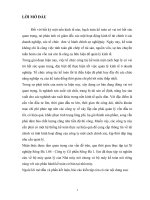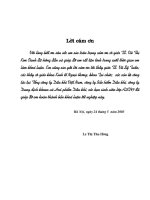04 tariff negotiation
Bạn đang xem bản rút gọn của tài liệu. Xem và tải ngay bản đầy đủ của tài liệu tại đây (323.18 KB, 63 trang )
SOUTH EAST ASIA
TRADE POLICY
TRAINING NETWORK
SEATRANET ADVANCED COURSE
NON AGRICULTURAL MARKET ACCESS (NAMA)
Module 3
TARIFF NEGOTIATIONS
1
SOUTH EAST ASIA
TRADE POLICY
TRAINING NETWORK
2
SOUTH EAST ASIA
TRADE POLICY
TRAINING NETWORK
Outline of Module 3
1. Nature of tariff Negotiations
2. Request – Offer Negotiations
3. Formula Negotiations
4. Sectoral Negotiations, including zero for
zero
5. Regional Agreements
6. The Doha Development Agenda (DDA)
3
SOUTH EAST ASIA
TRADE POLICY
TRAINING NETWORK
1. Nature of Tariff Negotiations
4
SOUTH EAST ASIA
TRADE POLICY
TRAINING NETWORK
Nature of Tariff
Negotiations
Domestic Priorities
• Export interests and import sensitivities
• Support of domestic Economic and
Social Policy
– Economic development, national or regional
– Social development, including employment of
women
– Political
5
SOUTH EAST ASIA
TRADE POLICY
TRAINING NETWORK
Export Interests and
Gender Equality
• Trade expansion creates jobs in export-oriented
sectors
• In many developing countries women often
account for 53-90% of workers in export sectors
• Women cannot easily move to more skilled or
highly paid jobs
• Export sectors can be identified, which create
new opportunities both in current jobs and for
future training.
6
SOUTH EAST ASIA
TRADE POLICY
TRAINING NETWORK
Import/Export Sensitivity and
Gender Equality
• Traditional export-oriented sectors – textile and
clothing – dominated by female employees may
continue to be treated as sensitive.
• Prospective, new, potentially more highly paid,
employment can be treated as sensitive on a
prospective basis.
• Clearly, trade policy by itself not a cure for
gender inequality, but rather part of a domestic
policy package aimed at taking advantage of
trade liberalization and minimizing any negative
effects.
7
SOUTH EAST ASIA
TRADE POLICY
TRAINING NETWORK
2. Request – Offer
Negotiations
8
SOUTH EAST ASIA
TRADE POLICY
TRAINING NETWORK
Request – Offer Negotiations
•Each Participant (Country) makes specific
requests of other countries, and they respond
with offers. Success is when the balance is
perceived as equal or approximate.
• Can have a target overall percentage reduction
or simply continue to exchange until offers are
exhausted and perceived balance is reached.
• These bilateral negotiations are kept secret
until agreement is reached.
9
SOUTH EAST ASIA
TRADE POLICY
TRAINING NETWORK
Benefits of Request –
Offer Negotiations
•Focused tariff reduction on areas of greatest
interest with level of reduction dependant on
interest.
•Potential for exclusion or minimization of
tariffs of greatest sensitivity.
•Potential for smaller economies to be free
riders (under the radar) as all benefits are
MFN.
10
SOUTH EAST ASIA
TRADE POLICY
TRAINING NETWORK
Negative Aspects of Request –
Offer Negotiations
• May result in narrowly-focused results with
relatively poor coverage across the range of
tariffs.
• Very time consuming and resource intensive.
• Depending on transparency, there may be
significant domestic resistance.
• Smaller economies may have little to say in
the overall shape of the agreement.
11
SOUTH EAST ASIA
TRADE POLICY
TRAINING NETWORK
3. Formula Negotiations
12
SOUTH EAST ASIA
TRADE POLICY
TRAINING NETWORK
Formula Approach
A formula for “across the board” reduction of
tariffs can be negotiated to be applied to an
agreed base tariff.
13
SOUTH EAST ASIA
TRADE POLICY
TRAINING NETWORK
Formula Approach
•There are two main types of formula:
– A tariff independent formula is not dependent, in
any way, on the initial tariff rate.
Simple example: just reduce every tariff by a fixed
rate.
– A tariff dependent formula is dependent upon
the initial tariff rate. Usually such a formula aims to
have greater reductions for high tariff rates and
smaller reductions for low rates.
14
SOUTH EAST ASIA
TRADE POLICY
TRAINING NETWORK
Formula Negotiations
• Negotiations of a formula also involves an
agreement on the phasing period of the
reductions.
15
SOUTH EAST ASIA
TRADE POLICY
TRAINING NETWORK
Benefits of a Formula Approach
• Once the coefficients in the formula have
been agreed on, the negotiation can be quite
simple, of short duration and not resource
intensive.
• During the negotiation the outcome of
particular coefficient values is predictable.
16
SOUTH EAST ASIA
TRADE POLICY
TRAINING NETWORK
Benefits of a Formula Approach
•Depending on the choice of formula, higher tariffs
are reduced by a greater amount, there is tariff
harmonization and a reduction in tariff peaks
•Depending on agreed flexibilities tariff reduction
is across the entire schedule, bringing about broad
liberalization
•There is less focused private sector resistance than
in the request – offer approach, as reductions are
spread across the schedule and the application is
relatively transparent and easy to explain.
17
SOUTH EAST ASIA
TRADE POLICY
TRAINING NETWORK
Problems of Formula Approach
•Because there is broad tariff reduction, particularly
sensitive products do not get special treatment.
•If tariff peaks represent greatest sensitivities, a tariffdependent formula will reduce them more than less
sensitive tariffs.
•If a single formula with a single coefficient is used,
all parties are treated the same, i.e. no differential
treatment for developing countries.
18
SOUTH EAST ASIA
TRADE POLICY
TRAINING NETWORK
4. Sectoral Negotiations
19
SOUTH EAST ASIA
TRADE POLICY
TRAINING NETWORK
Sectoral Negotiations
• Sector Negotiations lead to agreement to
reduce or eliminate tariffs for a specific
group of goods (sector or sub-sector) or for a
specific industry.
• Participants negotiate the definitions of the
sector then agree upon a timeframe for the
reduction or elimination of tariffs.
20
SOUTH EAST ASIA
TRADE POLICY
TRAINING NETWORK
Sectoral Negotiations
• May require specific member participation.
• Many informal sectoral agreements have
been negotiated through sector focused
request – offer negotiations.
21
SOUTH EAST ASIA
TRADE POLICY
TRAINING NETWORK
Examples of
Sectoral Negotiations
•The zero-for-zero sectoral negotiations in the
Uruguay Round.
–Products included pulp and paper, agricultural
equipment, beer, construction equipment, medical
equipment, steel products, pharmaceutical products and
brown spirits.
•Another UR sectoral agreement was on chemical
products, where it was agreed to harmonize tariffs at
a number of levels.
22
SOUTH EAST ASIA
TRADE POLICY
TRAINING NETWORK
Examples of
Sectoral Negotiations
–The attempt by APEC to negotiate “Early
Voluntary Sectoral Liberalization” (EVSL)
included 15 sectors (groups of products), nine of
which were fast tracked in 1998 then folded into
the new WTO Round.
–The “Information Technology Agreement” (ITA)
which was signed in 1996 and implemented in
1997.
23
SOUTH EAST ASIA
TRADE POLICY
TRAINING NETWORK
Benefits of Sectoral Approach
• After agreement on sectoral definitions,
negotiation is relatively simple and not time
Consuming.
• Negotiations are focused on products or
industries of greatest interest.
24
SOUTH EAST ASIA
TRADE POLICY
TRAINING NETWORK
Benefits of Sectoral Approach
•Considerable contact is required with
Industry, which, depending on each
country’s private sector relationship, may or may
not be resource intensive, but will lead to focused
private sector support.
•Sectoral Negotiations may provide opportunity for
focused discussions and/or negotiation of related
non-tariff measures.
25









